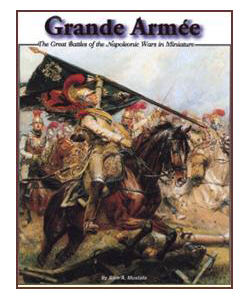|
|
|||||||||||||||
|
|
|||||||||||||||
 |
|||||||||||||||
 |
|
What’s Cooking? Grande Armée is the first rule set I purchased after a long search process. It is a grand tactical game designed for playing big battles in a reasonable amount of time. A long evening would probably suffice to play most scenarios, once the players were familiar with the rules. What sets it apart is the way in which it handles friction on the field. I did not want rules which contain what I call “guided-missile regiments” - units that always move exactly as desired, at the right time. This allows for extremely elaborate and convoluted battle plans to be carried out faultlessly. In Grande Armée an army commander truly has limited control of his army. Movement rates, turn lengths and game length are all variable!
List Of Ingredients Grande Armée comes as a spiral bound book. The interior pages are black & white, while both covers are full color and printed on heavy stock. The rules include 57 pages of actual rules, three more of optional rules, and four scenarios (Fuentes de Onoro, Aspern-Essling, Friedland and Waterloo). There is a page of tear-out charts printed on card stock, as well as a rules summary (Eclaireur) to be photocopied and used as a player aid. Players will need to make chits for tracking command points, as well as several unit statuses. How Big? How Many? How Long? Grand Armée has no definitive time or ground scale. A mile is roughly 19” but game turns are indeterminate. There is no figure removal, so players are free to use any figure ratio they like. Even movement rates are expressed as ranges (a base allowance plus a die-roll). The same is true of terrain cost: you just don’t know how fast that unit will move through that terrain (it varies every time, even for the same unit in the same terrain). Basing, Braising, and Roasting: How To Infantry and cavalry are mounted on 3 inch square bases, artillery on bases three by one-and-a-half inches. As there is no figure removal, players are free to use any number of figures in any scale they like. Diorama-style bases using 6 mm figures seem to be fairly popular. Note: many players use a reduced scale to fit scenarios on smaller tables. Most common are 2/3 scale using 2” square bases, and half-scale using bases reduced 50% in size. Which Comes First, Cheese or Salad?
Each turn in Grande Armée is comprised of pulses. The number of turns per game, and the number of pulses per turn are both variable. Each turn consists of the following phases: The Gourmet Touch Many of Grande Armée’s mechanisms are fairly straight forward. Here are some of the core concepts at play. Command Points: Each turn (not each pulse) each side has a limited number of Command Points to spend. These are used to either influence the initiative roll, assist in rallying broken units, or activate units. It goes without saying, I hope, that you never have enough CPs to do everything you want. You can leave some commanders to make their command roll, but even a strong leader can let you down. Skirmishing: This is represented very abstractly. Basically each unit has a skirmish rating from 0 to 2. To resolve an attack each player rolls a die, adding his SK value. If the attacker’s roll is higher than the defender’s one hit is inflicted. Otherwise there is no effect. Cavalry suppresses all enemy skirmishing within 2”. Another wrinkle: any unit which may skirmish attack must do so (this is out of the control of you, the army commander). The 6” Rule: Units within 6” of an enemy unit must either remain still, or else move directly toward or directly away from the enemy unit. In essence, at that distance they’re “so close that their commanders will turn them to face the enemy automatically, as a basic precaution” (p.35). Secondly if you start your move within 6” of an enemy unit, the brigade commander might act on his own. This is determined by a modified die roll. (Does not apply unless you move). In essence, once units close, they move beyond any detailed control by higher command. You can send them in or pull them out, but that’s about it until they clear the combat zone. The Kill Dice: Combat is a straight forward “kill dice” system. You roll one d6 for each strength point, plus any bonus dice (for leaders, etc.). Each die is then modified, with every result of 4 or higher resulting in a hit (there are a few exceptions). In some cases the defending unit gets a “saving throw” to try and offset a hit. The side causing the most hit wins the combat and the loser must retreat (neither side retreats in case of a tie). Not that there is no distinction made between “fire combat” and “melee.” A combat may represent a variety of different tactics and results, resolved with the “kill-dice” system. The Good, the Bad, and the Incomprehensible: I have spent the past few month reading quite a few rules sets. Whatever your opinion of the rules themselves, these are everything a rules set should be. Well laid out, with plenty of explanatory notes, a reasonable amount of white space on the page, and a sensible layout. The rule book is also peppered with quotes and illustrations. I especially like the way the designer’s notes are incorporated into the rules. They introduce and accompany each section, and they help frame the rules that follow. They do not intrude as they are separated in colored boxes to make sure they are not mistaken for the rules themselves. They are especially helpful in making sense of things like the lack of predictable movement rates or the “six-inch rule”. Can infantry really move faster than cavalry? Well, yes if the cavalry starts late, halts for some reason, gets lost on the way, etc. These rules will not be for everyone. First of all, to many gamers the Napoleonic period is about formations, and lots of ‘em. If you want to manage units at the formation level - choosing square, line, column, etc. - you will want to look elsewhere. Likewise if you like highly detailed (meaning lots of charts and lots of modifiers) in your combat you’ll want to keep looking. The simple “kill-dice” system here is speedy but probably won’t satisfy. Some gamers also feel the skirmish system slows the game down too much. Where to Get Help If the Smoke Alarm Goes Off Home Page: The author, Sam Mustafa, has put together an excellent home page which includes a detailed overview of the game, links to reviews, etc. Support: The author is a frequent contributor on the Grande Armée Yahoo group. This is quite an active group and a great place to turn for advice and more information. Links & Resources: |
 |
|||
|
|
|||
